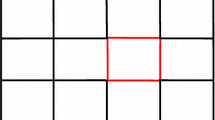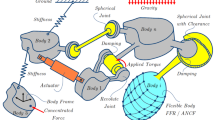Abstract
For simulation analysis and controller design mathematical models are necessary. This also applies to characterize the structural dynamics of mechanical systems, but current modeling approaches are limited to describe a restricted amount of predefined geometric points. A procedure to model the mechanical behavior of an arbitrary point along a line or within a surface area is missing. We propose a novel method to tackle this issue, by adapting Takagi–Sugeno Fuzzy Systems and combining them with the general linear description of mechanical systems. The presented method consists of two paths, each designed to meet a specific purpose, subject to numerical complexity and representation aberration. In the end, both cases lead to nonlinear differential equations, which provide a continuous estimation of the properties of an area. The accuracy and performance of our approach is verified by different experimental and simulation setups. One specific example is a galvanometer laser scanner, for which the new method is inevitable for a precise system modeling.











Similar content being viewed by others
References
Schweier M, Heins JF, Haubold WM, Zaeh MF (2013) Spatter formation in laser welding with beam oscillation. Phys Proced 41:20–30
Yamaguchi T, Hirata M, Pang CK (2014) Advances in high-performance motion control of mechatronic systems. CRC Press, Abingdon
Mnerie C A, Preitl S, Duma V-F (2013) Performance enhancement of galvanometer scanners using extended control structures. In: IEEE 8th international symposium on applied computational intelligence and informatics (SACI), Timisoara, pp 127–130
Yoo H W, Ito S, Verhaegen M, Schitter G (2013) Transformation-based iterative learning control for non-collocated sensing of a galvanometer scanner. In: 2013 IEEE 8th international symposium on applied computational intelligence and informatics (SACI), Timisoara, pp 1204–1209
Toyama S, Okado Y, Maeda Y, Iwasaki M, Hirai H (2013) Adaptive deadbeat feedforward compensation for robust positioning performance against plant perturbations. In: IEEE international conference on mechatronics (ICM), Vicenza, pp 670–675
Ewins DJ (1995) Modal testing: theory and practice. Research Studies Press, Taunton, Newtown
Maia NMM, Silva JMM (1997) Theoretical and experimental modal analysis. Research Studies Press Ltd., Taunton, Newtown
Pieczona SJ, Muratore F, Zaeh MF (2016) An approach for modeling the structural dynamics of a mechanical system based on a Takagi–Sugeno representation. In: Conference on competitive manufacturing, Stellenbosch, pp 391–398
Craig RR, Kurdila A (2006) Fundamentals of structural dynamics, 2nd edn. Wiley, Hoboken
Silva G, Le Riche R, Molimard J, Vautrin A (2007) Exact and efficient interpolation using finite elements shape functions. Technical Report hal-00122640. Available from https://hal.archives-ouvertes.fr/hal-00122640
Hughes T (2012) Finite element method: linear static and dynamic finite element analysis. Dover Publications, Mineola
Chen C-W, Yeh K, Chiang W-L, Chen C-Y, Wu D-J (2007) Modeling, H∞ control and stability analysis for structural systems using Takagi–Sugeno fuzzy model. J Vib Control 13:1519–1534
Chen C-W (2006) Stability conditions of fuzzy systems and its application to structural and mechanical systems. Adv Eng Softw 37:624–629
Ferreira CCT, de Oliveira Serra GL (2011) Fuzzy frequency response estimation from experimental data: definition and application in mechanical structures of aircraft and aerospace vehicles. In: 9th IEEE international conference on control and automation, vol 9, Santiago, pp 1225–1230
Gawronski WK (2004) Advanced structural dynamics and active control of structures. Springer, New York
Takagi T, Sugeno M (1985) Fuzzy identification of systems and its applications to modelling and control. IEEE Trans Syst Man Cybern 15:116–132
Tanaka K, Wang HO (2001) Fuzzy control systems design and analysis: a linear matrix inequality approach. Wiley, New York
Diepold KJ, Pieczona SJ (2012) Recurrent Takagi–Sugeno fuzzy interpolation for switched linear systems and hybrid automata. In: Proceedings of the IEEE international conference on fuzzy systems (FUZZ-IEEE), Brisbane, pp 1–8
Zadeh LA (1975) The concept of a linguistic variable and its application to approximate reasoning—I. Inf Sci 8:199–249
Kawamoto S, Tada K, Ishigame A, Taniguchi T (1992) An approach to stability analysis of second order fuzzy systems. In: Proceedings of first IEEE international conference on fuzzy systems, vol 1, San Diego, pp 1427–1434
Acknowledgements
The research project “Highly Dynamic Nonlinear Position Control of Galvanometer Laser Scanners by New Hardware and Control Concepts” is funded by the AiF within the framework ZIM of the Federal Ministry for Economic Affairs and Energy because of a decision of the German Bundestag. We thank our sponsors for their support.
Author information
Authors and Affiliations
Corresponding author
Rights and permissions
About this article
Cite this article
Pieczona, S.J., Zaeh, M.F. A methodology for areal modeling of structural dynamics based on a Takagi–Sugeno fuzzy system. Prod. Eng. Res. Devel. 11, 587–599 (2017). https://doi.org/10.1007/s11740-017-0748-1
Received:
Accepted:
Published:
Issue Date:
DOI: https://doi.org/10.1007/s11740-017-0748-1




